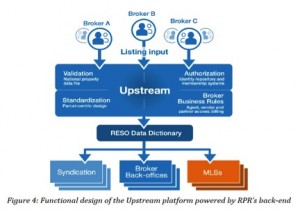 We’re starting to see the impact of a new leadership team at the National Association of REALTORS® led by Bob Goldberg, a strategic, yet practical leader that is SERIOUS about making the industry function more effectively. He also seems to be critically evaluating every investment in technology and making some bold moves to re-focus efforts.
We’re starting to see the impact of a new leadership team at the National Association of REALTORS® led by Bob Goldberg, a strategic, yet practical leader that is SERIOUS about making the industry function more effectively. He also seems to be critically evaluating every investment in technology and making some bold moves to re-focus efforts.
NAR announced yesterday that is shutting down development on its Advanced Multilist Platform, or AMP. AMP was under development for a few years at a burn rate of $6 Million per year. The concept behind AMP was solid – consolidate MLS data into a single data repository and allow developers of systems like Matrix, FlexMLS, Paragon, Stratus, Rapattoni, Navica and others focus on the front-end software development.
Most of all, the ambition was to provide more choice for MLS members to access MLS information and reduce costs to MLSs. There were a number of contrarian opinions about the idea. First of all, the price of AMP was estimated to be $5 per user per month. This was way off the goal of saving money. Large MLSs pay less than that for the entire MLS system. For AMP to succeed, they would have needed to hit a price point of about $1 or $2 at the most.
My hope is that NAR will donate the code to RESO and/or make it open source. At a recent broker town hall meeting in California, CAR President Joel Singer talked about the merits of a single MLS database with local service providers. I do not think that this idea will die along with AMP. Two MLSs in California are working on MLS Front End of Choice. Both the Los Angeles based California Regional Multiple Listing Service (CRMLS) and San Jose based MLSListings have CoreLogic®’s Matrix® product as their primary system and are integrating Black Knight Financial®’s Paragon MLS® as a secondary system. Both companies have been working on the project for about 2 years or more. Both companies already have an AMP-like database that is connected to Matrix. When the system goes live, agents will vote with their log in preference for one system over the other. The vendor’s only get paid for the users they support. Both Paragon and Matrix will be in a heated battle to serve the agent or watch their market share of users dwindle to their competitor. It will be interesting to watch.
It takes a very deep understanding of MLS databases to understand why all of this seems so easy on the surface, but is extremely difficult underneath. First of all, every MLS system has a unique database, commonly referred to as Native Database Schema. For the most part, CoreLogic, FBS, Rapattoni, Black Knight, Stratus and others each speak a different language at the database level. Each system has a database operation in its native language to create data, read data, update data, and delete data.
For years, MLSs have used a unique Real Estate Transaction Standard – called RETS. is a transaction standard, the Native data in the MLS data base is made available to be transmitted via RETS to another database.
When data sharing emerged, MLS vendors used RETS. This allowed data from one MLS to go into another MLS. The biggest datashare in America is in Southern California and involved as many as 6 MLS systems. The developer of the datasharing application is a product called Cornerstone, a database product that uses RETS for integrating MLS systems. Cornerstone is owned by BrightMLS, the nation’s second largest MLS with 85,000 users. To make it CARETS work, each of the participating MLSs used RETS. They also had to adopt the same rules. It was hard, and expensive. However, it works great and is still functioning today. CARETS mapped the different databases into one common standard.
RETS and the Upstream Pivot
 Now we can get to the good stuff. Out of the gate, Upstream planned to use the RETS for integrating into MLSs. Basically, Upstream is just another database that looks a lot like an MLS database. Then the Real Estate Standards created by RESO sunset RETS. Today, RETS is not dead, but the standard is going away. It is the method for MLS data sharing and making listings available to broker websites and other applications. However, in 2015, the standard was replaced by something called the RESO Web API. The RESO Web API is a term you need to learn. That is what replaces RETS. It relies on a standard called oData (open data protocol) is an international standard for organizing data, backed by Microsoft and a gazillion other companies. By adopting the Web API, the database systems in MLS applications and the products used by brokers and agents will be aligned with the rest of the software development universe.
Now we can get to the good stuff. Out of the gate, Upstream planned to use the RETS for integrating into MLSs. Basically, Upstream is just another database that looks a lot like an MLS database. Then the Real Estate Standards created by RESO sunset RETS. Today, RETS is not dead, but the standard is going away. It is the method for MLS data sharing and making listings available to broker websites and other applications. However, in 2015, the standard was replaced by something called the RESO Web API. The RESO Web API is a term you need to learn. That is what replaces RETS. It relies on a standard called oData (open data protocol) is an international standard for organizing data, backed by Microsoft and a gazillion other companies. By adopting the Web API, the database systems in MLS applications and the products used by brokers and agents will be aligned with the rest of the software development universe.
Products like FBS Spark, CoreLogic’s Trestle, Zillow Group’s Bridge Interactive and The Grid all offer the RESO Web API. The Web API was required to be adopted by every MLS to replace RETS in 2015/2016. The letter sent out to the 90 MLSs by Bob Goldberg this week was intended to warn bad MLSs who have not adopted the new standard. It’s 2018! They have had over 3 years. Until every MLS adopts the new RESO Web API, the real estate technology backbone cannot migrate away from RETS. Mainstream technology firms that serve brokers and agents will not switch away from RETS until the Web API can be used everywhere and RETS is turned off. Since RETS is working, the cost of change is not worth the benefits of speed, standardization, and efficiency of the RESO Web API.
Sidebar – do you remember how you had to have a complicated sync protocol to get contacts and calendar from your computer to your Palm Pilot or first Smart Phone. You would plug it in and it would sync? Many times it would create duplicates, or data would not move over correctly? It was a pain. That method is like RETS.
Do you notice how today when you add a contact into your phone it automatically syncs with your desktop without needing to run a sync application? That is using Web APIs. Web APIs are also used for data sharing across applications on your phone. You Authorize the Web API connection between your photos and Facebook the first time you want to post a picture on your phone to Facebook. That is a Web API. APIs are the foundational way that all software systems talk to each other.
Upstream is built on Web APIs using open data protocols. It is built for today’s modern best practices. There is no Web API standard available from RESO for Update. It would be irresponsible for Upstream to develop to RETS when we know that RETS is going away (and going away soon we hope).
RESO workgroups are creating the Web AP for update now, and it is expected to be completed this spring. Remember, RESO is a volunteer, non-profit organization. The Web API standard for Update will get done when it gets done. Once it is passed as a RESO standard, MLSs will have 1 year to support the new standard. If that adoption path is anything like what we have seen with the RESO Web API for distribution, it may take upwards of 3 years unless Bob Goldberg uses his hammer to drive rapid adoption. MLSs who do not invest in change will face the revocation of their NAR charter.
Given the state of affairs, the Upstream integration with MLSs is going slowly. There are a few MLSs that have database engineers that use APIs to power their MLS systems. MLSListings in San Jose and Regional MLS of Portland can both support the open data protocols and use Web APIs for two-way data transfer between the MLS and Upstream. Their integration with Upstream is in testing mode right now. It will be released in the next 30 days to the first users unless they discover some flaws that need to be fixed first. When it is released, a few brokers in MLSListings and Portland will input listings into Upstream and it will distribute the listings into the MLS, into the broker accounting system, into the broker’s virtual tour application, into the brokers marketing platform, into the broker’s transaction management system, onto the brokers website, sent out to buyers as alerts, syndicated to Zillow, etc. The broker will distribute the data in real time to all the places that need it, instantly. No more waiting for the old RETS system to sync everything. Upstream is real time.
While MLSs catch up with RESO Web API adoption, Upstream will work a lot like Listhub does today. Only it will use Web API instead of Listhub’s FTP or RETS transfer protocols. Upstream is instant, Listhub is 4 times a day.
Most of all, Upstream is not just for listings. None of the RETS systems like Listhub or the MLS has the ability to transfer the agent record or add and remove agents from applications. Upstream has these capabilities. When a broker adds a new agent, they enter the agent record once into Upstream, along with their headshot, bio, office information etc. That information is instantly transferred into every piece of software the broker uses or makes available to the agent. No more checklist for onboarding an agent (which typically takes a broker 2 hours to reenter the data into multiple systems manually today). For now, Upstream will pull data from the MLS and make it useful for the broker – faster and cheaper. When MLSs adopt the Web API for Update, they can plug into Upstream and get the data. In the meantime, Upstream will allow brokers to advance without the MLS holding them back. There will be duplicate entry into the MLS only.
Now that Realtor’s Property Resource is not trying to build AMP – they can focus their development resources on Upstream. Brokers want Upstream today. RPR can now double down their development efforts to get it to the goal line.




